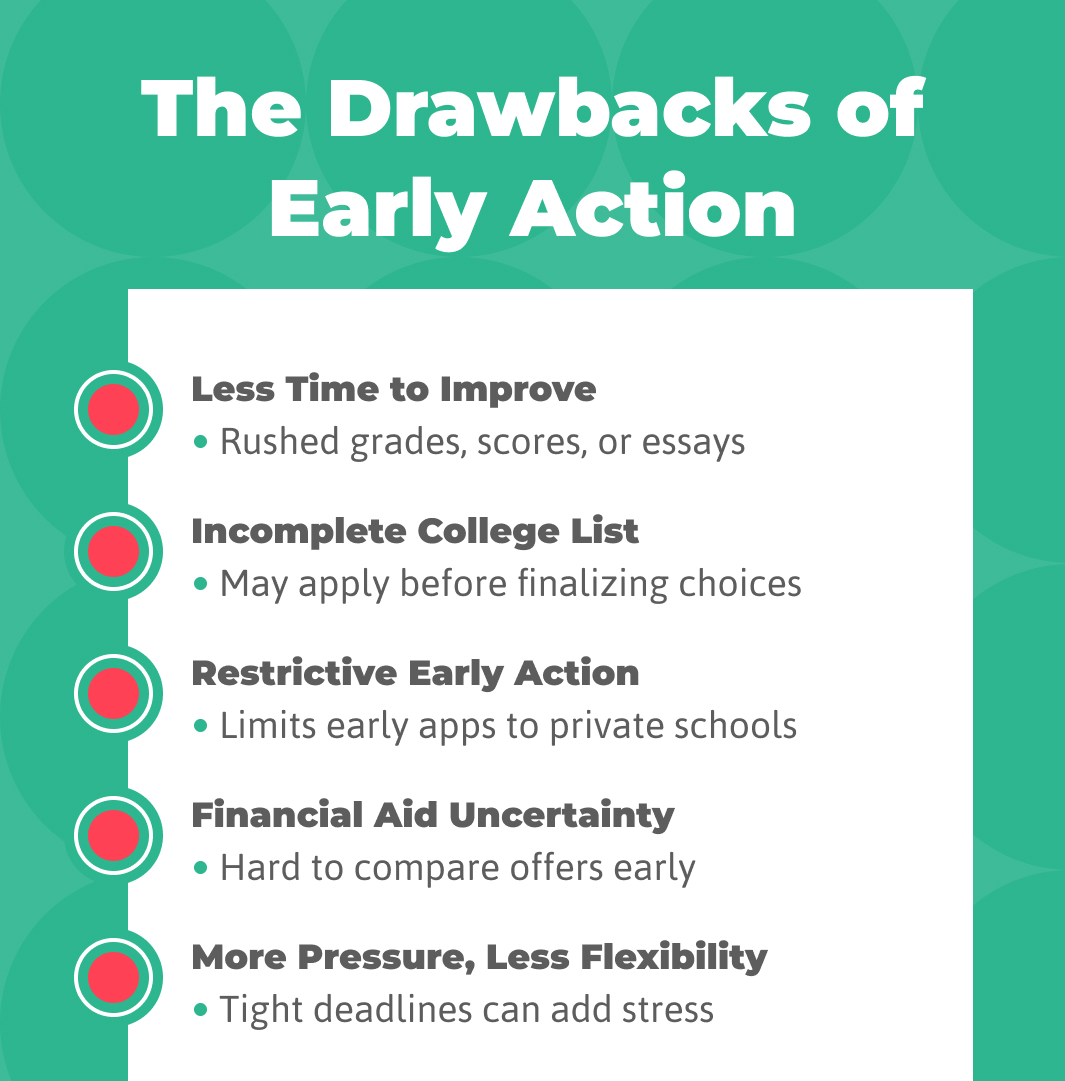- Blog
- > College Admissions
What Does Early Action Mean in College Admissions?
- Dr. Rachel Rubin
- | April 8, 2025

Choosing the right college involves navigating various application deadlines and decision plans. One option many students consider is Early Action. What do you know about Early Action vs. Early Decision, and how does it fit into the broader college application process?
Understanding the benefits and limitations can help prospective students make informed decisions about applying early.

Understanding Early Action
Early Action is a non-binding college application process that allows students to apply early and receive an admission decision sooner than regular applicants. Unlike Early Decision, which requires a binding commitment to one school, Early Action provides flexibility. Students can apply to multiple schools under Early Action while still having the option to compare each financial aid package before making a final choice.
For many students, applying early means reducing the time spent waiting for an admission decision. Early Action deadlines typically fall in November, with decisions released in December or January. This can provide a head start in the college planning process and alleviate some of the stress associated with waiting until the regular decision cycle.
Early Action vs. Early Decision
Many colleges offer both Early Action and Early Decision options, but they serve different purposes. Early Decision is a binding commitment, meaning if a student is accepted, they must attend that school. This option works best for students who have a clear first choice college and are confident in their financial situation.
Unlike Early Decision, Early Action applicants are not obligated to attend if accepted. They can still apply to multiple schools and weigh their options. This distinction makes Early Action an attractive choice for students who want to show interest in a college early without the commitment of Early Decision.
The Benefits of Applying Early Action
Applying early action has several advantages for students waiting for undergraduate admission. Most colleges regard early applicants highly when making the final admissions decision.
Early Admission Decisions
Students who apply early receive admission decisions months before regular decision applicants, giving them more time to plan.
Increased Acceptance Rates
Some schools admit a significant portion of their class early, meaning Early Action applicants may have a better chance of acceptance.
Priority Consideration
Early Action applicants often receive priority consideration for merit scholarships and financial aid packages.
Less Stress in Senior Year
Receiving an early decision allows students to focus on their senior year grades without the uncertainty of waiting for responses.

The Drawbacks of Early Action
While Early Action has many benefits, it’s not the right choice for every student. Some students may need additional time to strengthen their applications, improve test scores, or finalize their college list. Additionally, some competitive universities offer Restrictive Early Action, which limits students from applying early to multiple private colleges.
Students should also be aware that financial aid offers may not be available at the time of early admission decisions. Comparing financial aid offers from multiple schools is an important part of the decision-making process, and applying early could limit the ability to assess all options.
How Early Action Affects Financial Aid
Financial aid plays a crucial role in many students’ college choices. Since Early Action is not a binding contract, students can compare financial aid offers from multiple colleges before making a decision. However, it’s important to note that financial aid packages may not be available at the time of early admission decisions, so students should use net price calculators to estimate costs before applying early action.
For students concerned about financial aid, Regular Decision may provide more time to compare offers and appeal for additional assistance if needed. Early Action applicants should carefully research each college’s financial aid policies to determine the best course of action.

Who Should Apply Early Action?
Early Action is a great option for students who feel prepared to submit a strong college application ahead of Regular Decision deadlines. This option allows students to put their best foot forward while keeping their options open.
For students with high class rank, a solid GPA, and competitive standardized test scores, Early Action can be beneficial. If your junior year grades reflect a strong upward trend, Early Action may highlight your academic growth.
For students who have already explored college options and are confident in their choices, Early Action allows you to apply early without the commitment of a binding agreement, as is the case with Early Decision.
For students who seek merit-based awards, applying early can increase your chances of receiving these opportunities. Some institutions even have early decision plans and early application options that factor into financial aid distribution.
For students who desire extra time to prepare, Early Action applicants receive their admission decision months before regular decision applicants. This allows ample time to compare schools, visit campuses, and review financial aid packages before committing.
For students who have finalized their application materials, such as essays, recommendation letters, and transcripts, and are ready to submit, Early Action can be a strategic advantage.
For students who need more time to strengthen their academic record, improve their standardized tests, or explore additional options, waiting for Regular Decision may be the best path. Applying early can be advantageous, but students should weigh their options carefully to determine the best approach for their unique goals.
How to Apply Early Action
Applying Early Action requires careful planning. Students should:
- Research colleges early to determine which schools offer Early Action
- Meet with a school counselor to discuss their application strategy
- Prepare application materials, including essays, recommendation letters, and standardized test scores
- Submit applications by the Early Action deadline, typically in November
Many schools notify Early Action applicants in December or January, giving students ample time to compare options before making a final decision in the spring.
Making the Right Choice for You
Early Action offers students the opportunity to apply early and receive admission decisions sooner, providing a head start in the college admissions process. While it has advantages, including priority consideration for scholarships and less stress during senior year, it’s important to weigh the potential drawbacks, particularly regarding financial aid and application readiness.
For students navigating the complex world of college admissions, expert guidance can make all the difference. Spark Admissions has the highest college admissions success rate in the country. Contact us today to learn more about our admissions consulting services and find the best path for your future.


